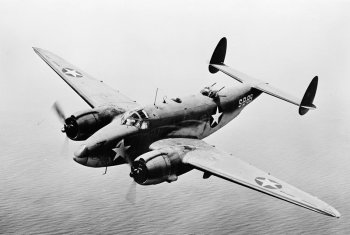![]() The Pacific War Online Encyclopedia
The Pacific War Online Encyclopedia
|
| Previous: Puttick, Edward | Table of Contents | Next: PV-2 Harpoon, U.S. Patrol Bomber |

Library of
Congress. Via Wikipedia
Commons
Lockheed PV-1/B-34 Ventura
| Crew | 4 or 5 |
|
Dimensions |
65'6" by 51'9" by 11'11" 19.96m by 15.77m by 3.63m |
|
Weight |
20,197-31,077 lbs 13,697-14,096 kg |
|
Speed |
322 mph at 13,800 feet 518 km/h at 4200 meters |
|
Cruising speed |
164 mph 264 km/h |
| Rate of climb | 37
feet per second 11.3 meters per second |
|
Ceiling |
26,300 feet 8020 meters |
| 2 1850 hp (1379 kW) Pratt & Whitney R-2800-S1A4G Double Wasp 18-cylinder radials driving three bladed propellers. | |
|
Armament |
Dual 0.50
machine gun nose turret Dual 0.50 machine gun dorsal turret Two ventral 0.30 machine guns |
|
Bomb load |
3000 lbs (1360 kg) internal 2000 lbs (910 kg) under wings |
|
Range |
1660 miles 2670 km |
| Sensors |
ASD surface search radar |
| 2475 of all models |
The Ventura was developed from the Lodestar transport to British
specifications in 1940. Deliveries began in June 1942 with the PV-1. It
was initially employed by the British as a daylight strategic bomber,
at which it was not terribly successful in spite of a strong start with
its first mission over Eindhoven. The British aircraft were reallocated
to Coastal Command and the remaining production was widely distributed
among the Allies
as a training and patrol
aircraft. A few of the Marine
aircraft were
converted to night fighters
with airborne intercept radar, and
saw
modest success in the Solomons.
The PV-1P was a photoreconnaissance
variant.
References
The Pacific War Online Encyclopedia © 2007 by Kent G. Budge. Index